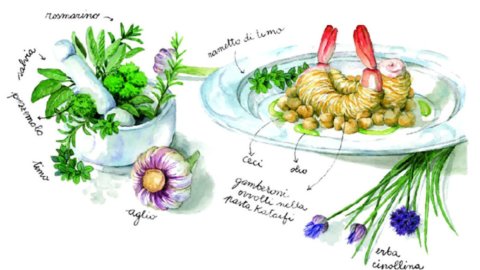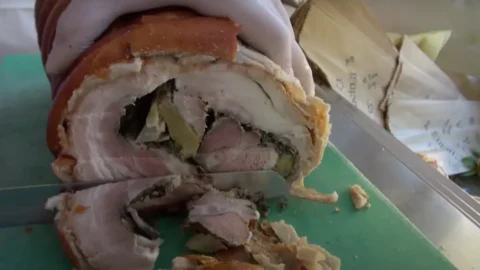As a child, his great-grandmother looked at his small, elegant hands and predicted a bright future for him as a doctor. There grandmother, perpetual at a parish priest of Medicine, a small town in the Bolognese plain, was instead very attached to the land, its products, its flavours, she loved to pass on to her little nephew who listened to her with great attention the values of the tradition of a simple life of provincial people who marked their agricultural existence following the course of the seasons. Among other things, and it wasn't irrelevant, the grandmother was also very good in the kitchen and the little one grew up with the scents and flavors of her cooking.
“It was she who taught me to cook – he later recalled – She was very rigorous: at the table every day he questioned us about the food we had on our plate, he asked the season of tomatoes, peas, flowers. And when we were disobedient, she didn't beat us with her hands, but she took giant nettle leaves behind the house and chased us, hitting us on the legs."
Teachings put to good use by the young man who, from the kitchen of a perpetual, endangered world of which evidence remains only in the novels and black and white films, would set off on a path that would lead him to become Bruno Barbieri, two-starred chef, record holder for a long time of Michelin stars, no less than seven, before being beaten by Enrico Bartolini, name that inspires fear among competitors of Masterchef dalways, being the only one to have participated in all ten editions of the format in which he has been joined, over the years, by Carlo Cracco, Joe Bastianich, Antonino Cannavacciuolo, Antonia Klugmann and Giorgio Locatelli.
His was an Emilian family of Lucan origins, but his father Nello left the family when he was seven years old to move to Spain. Bruno then lived with his mother Ornella who worked in textiles and who passed on to him the taste for refinement and elegant fashion. But who sealed his fate was actually his grandmother who kept him close in the kitchen, making him have his first early gastronomic experiences and who above all made him understand the importance of peasant and genuine values in the kitchen as in his life. That grandmother capable of getting up at three or four in the night to go and check the gestation of the cow and then the birth of the calf, which she took with her to the fields in search of wild vegetables and even truffles. “So that at the age of three – she recalls today with a lot of nostalgia – I was already eating homemade tagliatelle with truffles, the white ones – she is keen to underline – not scorzoni”. And with her grandmother she also learns to make bread, to work with cheese, and to knead the dough, to prepare jams and preserves.
After receiving the first notions from his grandmother, young Bruno sets off on his own path: he graduated from the hotel management school in Bologna and in 1979 was employed as a second cook on ships cruise which will allow him to get to know the culinary cultures of different nations, and which he will subsequently deepen with specialization courses abroad. The return to Italy at this point is in a big way because Barbieri lands at the Locanda Solarola in Castel Guelfo with two Michelin stars. The next and decisive step for its formation and growth is theTrigabolo di Argenta experience, legendary Igles Corelli restaurant, two Michelin stars and a great school for future generations of top chefs, where he will have the opportunity to cook for Andy Warhol.
The next step is one of the most prestigious, the direction of the restaurant kitchens Arquade di Villa del Quar, five-star luxury hotel of international stars and of the heads of state in Verona directed by Leopoldo Montresor and by Evelina Acampora, great hotel manager. And here will come the first consecration of his ingenious cuisine, two Michelin stars. Always restless and hungry for knowledge, Barbieri leaves Arquade after four years to move to Brazil, to then return to Europe where he opens the Cotidie restaurant in London which he sells a year later, to then throw himself into the adventure of the Fourghetti in Bologna sold three years later to Erik Lavacchielli.
Restless, he can't help himself in an experience that binds him to a place. He immerses himself in a frenetic activity as a gastronomic, editorial and television organizer and consultant. Not only Masterchef but also the 4 Hotel format, produced by Sky Italia. And he also found the time to participate in those football as sent
To give a refined touch to the dinners at the end of the year and at the beginning of the year, we asked Bruno Barbieri for a suggestion for the readers of Mondo Food. The recipe for "shrimp rolls in kataifi paste with rosemary-scented chickpeas" gives an international imprint to the table. The inspiration came to him during a trip to Beirut. Convinced supporter of the importance of not limiting the horizons of the kitchen but of opening them to contaminations with different cultures because only in this way can the kitchen be renewed and enriched while maintaining fidelity to its origins, Barbieri has studied this dish as an ideal meeting place for Mediterranean flavours. Kataifi paste, a typical ingredient of Greek, Turkish and Middle Eastern cuisine, essentially used in confectionery, makes dishes crunchy and tasty, but chefs have long used it for effective preparations. Chickpeas have Turkish origins but they quickly spread throughout the Latin world and throughout the Mediterranean. For the record Cicero derived his name from the fact that he descended from an ancestor who had a characteristic chickpea-shaped wart on his nose. Sicilian prawns are a highly prized species. Rich in beneficial substances for the body such as iron, potassium, selenium, phosphorus and calcium. The red ones from Mazzara del Vallo are famous for their unsurpassed flavour.
The recipe: prawns in kataifi paste with chickpeas flavored with rosemary
Ingredients:
for 4-6 people
• 12 shelled and well cleaned prawns
• 300 g of chickpeas
• 1 onion
• 1 carrot
• 1 celery
• 100 g of butter
• kataifi pasta to taste (available frozen or vacuum-packed in Middle Eastern specialty shops or in well-stocked delicatessens)
• spices: rosemary, thyme, sage, chives and parsley to taste
• 1/2 glass of extra virgin olive oil
• peanut oil
• Salt and Pepper To Taste
Method
After leaving the chickpeas to soak for 12 hours, drain them, rinse them and put them with all the other cold vegetables in a saucepan with plenty of water. Bring to a boil, skimming if necessary.
When almost cooked, after about 40 minutes, season with salt and pepper and remove from the heat. Leave to cool in their cooking water and once cold, peel them. Meanwhile, on a fish cutting board we have a tuft of kataifi pasta needed to wrap a prawn, previously brushed with melted butter.
Roll up and repeat the same operation for the other prawns.
At this point, season the chickpeas with extra virgin olive oil and the chopped aromatic herbs.
Fry the skeins of prawns at 140 °C in abundant peanut oil, taking care to throw in a few pieces at a time so as not to lower the heat of the oil (otherwise the prawns will end up boiling instead of frying by absorbing the oil).
Then drain and salt them.
Introduction
Arrange the chickpeas in the center of a bowl, place 2 skeins of prawns on top and garnish with a sprig of fresh thyme.






